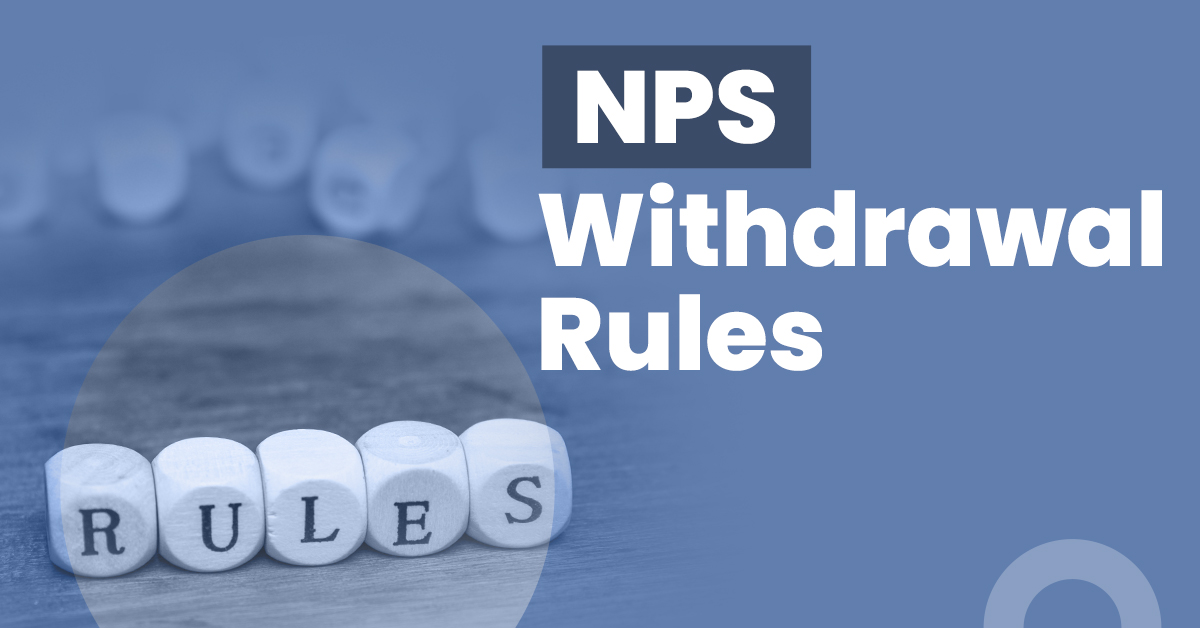NPS Withdrawal Rules: All You Need to Know


The National Pension Scheme (NPS) is a fixed-income investment scheme that allows you to build a corpus for your post-retirement life. It is a Government-backed scheme that comes under the Pension Fund Regulatory and Development Authority (PFRDA) jurisdiction. You can invest funds in your NPS account periodically during your employment and withdraw them once you retire.
For example, suppose you are 35, and the retirement age is 60, the total investment duration will be 25 years with a return of 10%(indicative rate). If you contribute even the minimum amount of Rs. 1000 monthly, you will gather a substantial corpus of approximately Rs. 13 lakhs.
You can withdraw the corpus as a lump sum or annuity after attaining 60 years of age. Premature withdrawals are allowed, too, subject to your meeting various parameters. However, there is a cap on how much you can withdraw based on your corpus, age etc.
If you are an active subscriber to the scheme, it is crucial to know how to withdraw money from NPS. This article will explain various rules of NPS withdrawal to ease your investment process.
How to Withdraw from NPS?
You will receive a communication from the Central Record-keeping Agency (CRA) about six months before your attainment of 60 years to begin the claim in the CRA system. Further, a claim ID will be allocated for your request after initiating the withdrawal claim. PFRDA has made the online withdrawal process mandatory since 2016, and the CRA processes online requests only. So, here’s how to withdraw from NPS.
- Using online mode
You can directly obtain the NPS withdrawal form using your User ID and IPIN in the CRA system. However, you must do so within six months before retiring.
- Using offline mode
There is no option to apply for withdrawal online in the case of a Tier II account. Therefore, you must visit the nearest point of presence (PoP) to fill out the UOS-S12 form and attach the relevant documents. The associated PoP will initiate the request and disburse the amount in your bank account within three days.
NPS Premature Withdrawal Rules Tier I and II
There are two types of accounts under the NPS: Tier I and Tier II.
The Tier I account in NPS is suitable for retirement planning. You contribute to it for the long term with some premature withdrawals until maturity. Tier II accounts, on the other hand, are more like voluntary savings accounts. You can withdraw funds at any time.
There are different rules for premature withdrawal in both versions. Let’s find out how the early NPS withdrawal procedure works for Tier I and Tier II accounts.
Premature withdrawal in Tier I
You can withdraw from a Tier I account for big-ticket spendings such as children’s marriage or higher education and medical emergencies. However, premature withdrawal can be done only after holding the account for at least three years. The guidelines differ based on the accumulated funds in your account:
- Less than or equal to Rs. 1 lakh
You can withdraw funds in a lump sum with the benefit of tax exemption.
- More than Rs. 1 lakh
You invest 80% of the total funds on the annuity, while the remaining 20% is available for withdrawal, subject to income tax.
Tier I accounts allow both online and offline withdrawal. You can access the NPS withdrawal form on the official website of CRA-NSDL.
Premature withdrawal in Tier II
An NPS Tier II account is similar to a regular savings account as it lets you withdraw money at your convenience. But, the procedure is disparate and long-drawn. The NPS Tier 2 withdrawal process requires you to physically visit the point of presence(PoP). The lack of an online facility and the availability of only a few PoPs make NPS Tier II withdrawal a lengthy process.
However, to make any withdrawal, regardless of TIER I or II, you must possess the following documents:
- Original PAN Card.
- An undertaking cum request form if you are eligible for complete withdrawal.
- Filled advance stamped receipt with your signature and the revenue stamp.
- KYC documents, i.e., driving licence, NREGA card, Aadhaar card, Voter’s Identity Card, Passport, and PAN card.
- Bank passbook, bank certificate with proof of your name and number, bank’s letterhead, cancelled cheque, and IFSC code.
Also Read: PFRDA – Pension Fund Regulatory and Development Authority
Rules to Withdraw from NPS
NPS withdrawal rules and guidelines are based on the subscriber’s employer. These are the regulations applicable to the different sectors and situations:
- Government sector subscribers on retirement:
- You can withdraw the total amount if it is less than or equal to Rs. 5 lakhs.
- You can extend the withdrawal till you reach 70.
- You must use 40% of the amount in annuity plans and take the rest as a lump sum.
- Government sector subscribers opting for voluntary retirement:
- You can withdraw all the funds if they are less than Rs. 2.5 lakhs.
- You can withdraw up to 20% of the corpus and it is a must to purchase annuity plans worth 80% of the amount.
- Death of the government sector subscriber
- The legal heir or nominee receives the total amount in case the subscriber dies before retirement.
- Corporate employees on retirement
- You can withdraw the entire amount if it is less than Rs. 5 lakhs.
- You can postpone withdrawal till the age of 70.
- If the corpus is more than 5 Lakhs, You can withdraw up to 60% of the total corpus and it is a must to invest 40% of the funds in annuity plans.
- Corporate sector subscribers opting for voluntary exit
- You must have the account for at least ten years.
- You can withdraw the total amount if it is less than or equal to Rs. 2.5 lakhs.
- In case of a corpus exceeding Rs 2.5 lakh You can withdraw a maximum of 20% and purchase an annuity plan using 80% of the funds is compulsory.
- Death of the Corporate sector subscriber
- The nominee can choose to withdraw the amount in a lump sum in case the subscriber is no more.
NPS Exit Rules
The maturity term for NPS was earlier set at 60 years. But, after observing the disparity in the retirement ages in firms, the regulatory body altered this rule. The National Pension Scheme now allows an exit option for you at the retirement age set by your employer.
It must be remembered that purchasing annuity plans with 40% of the funds is mandatory. You can withdraw the remaining as a lump sum or in instalments per your preference. However, if you do not wish to go with this option, the following alternatives are available:
- You can extend the purchase time of the annuity to three years. Your corpus withdrawal can be detained based on the market conditions if you are an active equity investor.
- You can postpone the 60% NPS withdrawal until you reach 70, when you can withdraw the funds as a lump sum or in instalments.
It is vital to submit a written request 15 days before your retirement to the concerned authority to avail of either option.
Final Thoughts
NPS provides an easy and foolproof way to gather a sizable corpus for the post-retirement years. The scheme does not have prerequisites other than the subscriber meeting the age criteria. Nonetheless, many subscribers find withdrawing and exiting from the plan a hassle owing to inadequate information. As a result, it is critical to understand the rules, from the fundamentals to the tax benefits available at the time of withdrawal, to take advantage of them when retiring.
FAQs
How to submit an NPS withdrawal claim?
You can request a claim to withdraw the corpus by applying and submitting the required documents. You can approach the nearest nodal office or PoP for the submission.
How can I initiate the withdrawal request in the CRA system?
You can request NPS withdrawal online using your NPS account login. The associated PoP will verify and authorise the request further. You might have to physically submit the NPS withdrawal form with the required documents in case the online service fails.
How will I receive my NPS corpus?
Once the associated PoP has validated and authorised your withdrawal request, you will receive the amount directly in your bank account via electronic mode only. It is, therefore, crucial to give the correct bank details.
What will happen if I close my Tier-I account?
Your Tier-II account will also close when you request the closure of Tier-I. The Tier-II amount will be redeemed and transferred to your registered bank account.
Does NPS allow partial withdrawal?
Yes! You can request a partial NPS withdrawal under certain conditions. For example,
The applicant should have had an NPS subscription for three years.
The withdrawal amount must be less than 25% of the total investment.
There should be a specific reason behind the partial withdrawal, like children’s marriage, serious accidents, critical illness, etc.
There can be a maximum of three withdrawals during a subscription period.







